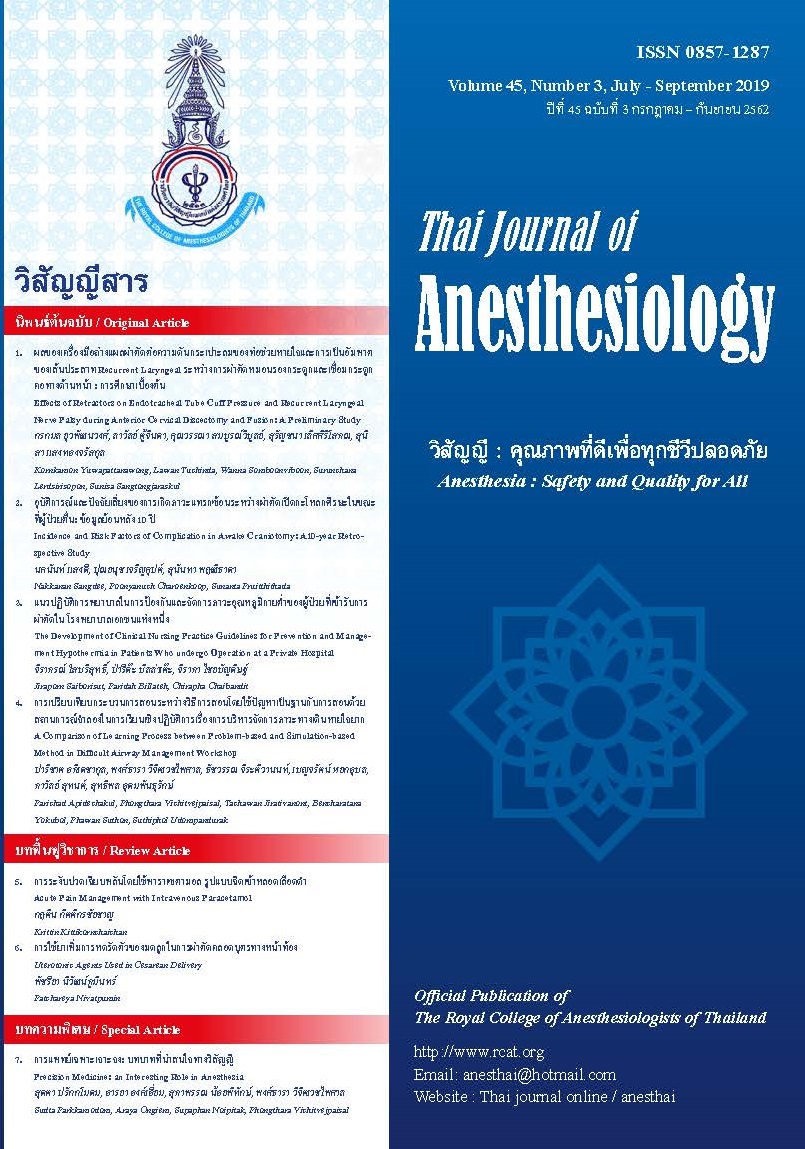Effects of Retractors on Endotracheal Tube Cuff Pressure and Recurrent Laryngeal Nerve Palsy during Anterior Cervical Discectomy and Fusion: A Preliminary Study
Main Article Content
Abstract
Background: The surgical retractor had been applied to
visualize the anterior cervical spine during anterior cervical
discectomy and fusion (ACDF). As a result, the recurrent
laryngeal nerve was trapped between retractor and
endotracheal tube (ETT) cuff. An increasing of ETT cuff
pressure with retractor placement might produce recurrent
laryngeal nerve palsy.
Objectives: The aim of the present study was to observe
the effects of retractors and changes in ETT cuff pressure
and to evaluate the influence of ETT cuff pressure
adjustment after retractor placement on postoperative
dysphagia, hoarseness and sore throat.
Methods: A prospective randomized clinical trial was
undertaken with 24 patients scheduled for elective ACDF.
Patients were randomized into four groups: group (A); ETT
cuff pressure was adjusted and maintained at 20 mm Hg
after retractor placement without N2O anesthesia, group
(B); ETT cuff pressure was not adjusted after retractor
placement without N2O anesthesia, group (C); ETT cuff
pressure was adjusted and maintained at 20 mm Hg after
retractor placement with N2O anesthesia and group (D);
ETT cuff pressure was not adjusted after retractor
placement with N2O anesthesia. ETT cuff pressures and
peak airway pressures were continuous recorded.
Postoperative dysphagia (Bazaz dysphagia scale),
hoarseness (GRBAS) and sore throat (NRS; 0-10) were
followed up at 24 h and 1 mo.
Results: 24 ASA physical status I-III patients were
evaluated. There was significantly increased in ETT cuff
pressure values after retractor application when compared
to the baseline values in 4 groups. There was no significant
difference in changed ETT cuff pressure and peak airway
pressure values between N2O anesthesia (C, D) and
without N2O anesthesia (A, B) groups at the same period
of time. Postoperative dysphagia, hoarseness and sore
throat were found in all patients. The data showed
significant lower of the Bazaz dysphagia scale and the
severity score of hoarseness (GRBAS) in the adjustable
ETT cuff pressure to maintain 20 mm Hg after retractor
replacement groups (A, C) at 24 h postoperatively (p <
0.001). However, there was no significant difference in the
NRS of sore throat among 4 groups.
Conclusions: ETT cuff pressure significantly increased
after retractor replacement during ACDF. An increasing of
the cuff pressure was not affected by nitrous oxide used.
Adjusting to maintain ETT cuff pressure at 20 mm Hg after
applied cervical retractor reduced the severity of dysphagia
and hoarseness.
Article Details
References
tube cuff pressure at 20 mm Hg to prevent dysphagia after
anterior cervical spine surgery; protocol of a double-blind
randomised controlled trial. BMC Musculoskeletal Disorders
2013; 14:280.
2. Kriskovich MD, Apfelbaum RI, Haller JR. Vocal fold paralysis
after anterior cervical spine surgery: Incidence, mechanism,
and prevention of injury. Laryngoscope 2000; 110:1467-73.
3. Audu P, Artz G, Scheid S, et al. Recurrent laryngeal nerve
palsy after anterior cervical spine surgery: The impact of
endotracheal tube cuff deflation, reinflation, and pressure
adjustment. Anesthesiology 2006; 105:898-901.
4. Jung A, Schramm J: How to reduce recurrent laryngeal nerve
palsy in anterior cervical spine surgery: a prospective
observational study. Neurosurg 2010; 67(1):10-15.
5. Apfelbaum RI, Kriskovich MD, Haller JR. On the incidence,
cause, and prevention of recurrent laryngeal nerve palsies
during anterior cervical spine surgery. Spine 2000; 25:
2906-12.
6. Garg R, Rath GP, Bithal PK, et al. Effects of retractors
application on cuff pressure and vocal cord function in
patients undergoing anterior cervical discectomy and fusion.
Indian J Anaesth 2010; 54:292-5.
7. Kim SW, Shin H. Postoperative tracheal mucosa ischaemia
by endotracheal cuff pressure change during the anterior
cervical spine surgery. J Korean Neurosurg Soc 2006;
39:419-22.
8. Mitchell V, Adams T, Calder I. Choice of cuff inflation medium
during nitrous oxide anaesthesia. Anaesthesia 1999;54:32-6.
9. Ahmad NL, Norsidah AM. Change in endotracheal tube cuff
pressure during nitrous oxide anaesthesia: A comparison
between air and distilled water cuff inflation. Anaesth
Intensive Care 2001; 29:510-4.
10. Tramer M, Moore A, McQuay H. Omitting nitrous oxide in
general anaesthesia: meta-analysis of intraoperative
awareness and postoperative emesis in randomized
controlled trials. Br J Anaesth 1996; 76:186-93.
11. Sperry RJ, Johnson JO, Apfelbaum RI. Endotracheal tube
cuff pressure increases significantly during anterior cervical
fusion with the caspar instrumentation system. Anesth Analg
1993; 76:1318-21.
12. Liu J, Zhang X, Gong W, et al. Correlations between
controlled endotracheal tube cuff pressure and
postprocedural complications: a multicenter study. Anesth
Analg 2010; 111(5):1133-7.
13. Tan TP, Govindarajulu AP, Massicotte EM, Venkatraghavan
L. Vocal cord palsy after anterior cervical spine surgery:
a qualitative systematic review. The Spine Journal 2014;
1332-42.
14. Bulger RF, Rejowski JE, Beatty RA: Vocal cord paralysis
associated with anterior cervical fusion: considerations for
prevention and treatment. J Neurosurg 1985; 62(5):657-61.
15. Bertalanffy H, Eggert HR. Complications of anterior cervical
discectomy without fusion in 450 consecutive patients. Acta
Neurochir 1989; 99:41-50.
16. Braz JR, Volney A, Navarro LH, Braz LG, Nakamura G. Does
sealing endotracheal tube cuff pressure diminish the
frequency of postoperative laryngotracheal complaints after
nitrous oxide anesthesia? J Clin Anesth 2004; 16:320-5.
17. Sole ML, Penoyer DA, Su X, et al. Assessment of endotracheal
cuff pressure by continuous monitoring: a pilot study. Am J
Crit Care 2009; 18:133-43.
18. Nordin U. The trachea and cuff-induced tracheal injury. An
experimental study on causative factors and prevention. Acta
Otolaryngol Suppl 1977; 345:1-71.
19. Goodman EJ, Cesar CA, Koziol JM. The incidence of high
endotracheal tube cuff pressure in a busy suite of operating
rooms. Anesth Analg 1998; 86: 539s.
20. Braz JR, Navarro LH, Takata IH. Endotracheal tube cuff
pressure: need for precise measurement. Sao Paulo Med J
1999; 117:243-7.


